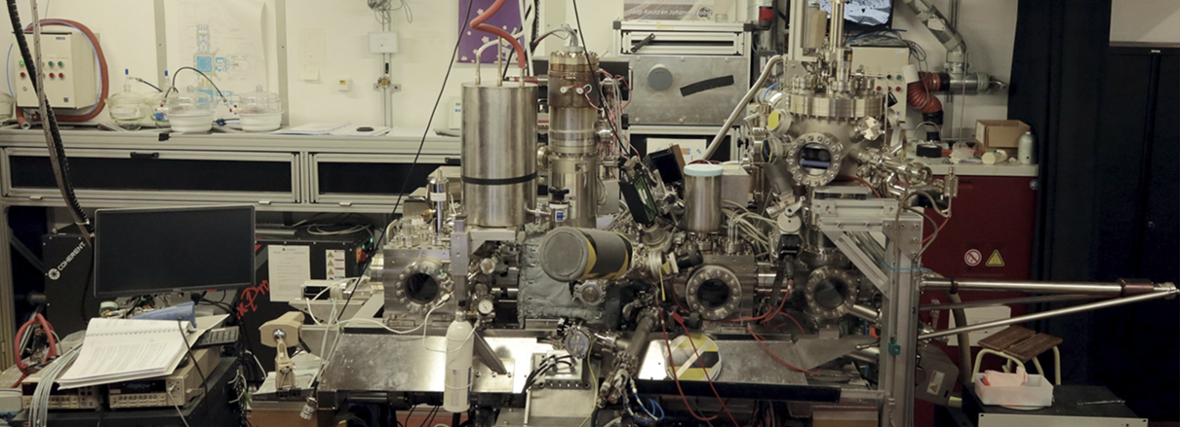
Physicist Sense Jan van der Molen plays ‘Dutch shuffleboard’ with electrons
image: Sense Jan van der Molen
Physicist Sense Jan van der Molen researches materials that do not exist in nature. ‘It’s fascinating to see how the properties of a material change if we manage to make it super thin.’ He will give his inaugural lecture on 21 October.
Van der Molen is working on building new materials. ‘With my colleagues I want to be able to design materials with properties that we determine beforehand. We do fundamental research to decide which building blocks we need to use for this.’
Van der Molen is Professor of Physics of Condensed Matter, which means that as a physicist he does research into solids. His discipline answers questions such as: Why is glass transparent while copper is not? And why does copper conduct electricity while glass does not? This appears to be determined by the behaviour of the electrons in the material.
‘With my colleagues I want to be able to design materials with properties that we determine beforehand.’
Superconductor
A famous example of one such new material is double-layer graphene. Everyone has graphene at home. The graphite centre of a pencil consists of a bunch of layers of graphene, each exactly one carbon atom thick. Van der Molen: ‘If you place two layers of graphene exactly on top of each other and turn the top layer a tiny bit (exactly 1.1 degrees, ed.), you get a superconductor.’
Superconductivity is special. It means electricity can travel through a material without resistance. A disadvantage is that the material has to be around minus 270 degrees Celsius to be superconductive, which makes it difficult to use in practice. Physicists are therefore looking for superconductors that need less cooling.
Nature is bursting with materials like graphite. By combining one-atom-thick layers of different materials, you can make materials that do not exist in nature. ‘There are endless possibilities but we need to find the right recipes,’ says Van der Molen. ‘The good thing is that we can do loads of experiments to find this out. If we do these properly, we could be thinking of applications like new sensors or specific semi-conductors.’
‘You can roughly predict what the properties of a new material will be but you only really know after a proper experiment.’
Experiments
Van der Molen and his colleagues experiment in different ways. One way is to look at electric conductivity, so by sending electricity through the material. ‘But anyone can do that,’ says Van der Molen. ‘We can do it a bit differently here in Leiden. We use an electron microscope to look at the atomic layers, which means you can study them in more detail.’
Van der Molen compares the electron microscope with the Dutch game of sjoelen (or Dutch shuffleboard as it is sometimes known, see the video below of the first sjoelen World Championship). The game involves sliding pucks along a board and trying to get them into one of the slots. In Van der Molen’s work, the pucks are the electrons that are fired at the material. The material accepts some electrons but not others. This depends on their energy.
The material can therefore be compared with the plank with the slots in it in the board. If you slide a puck and it bounces back, you know that there isn’t a slot. If the puck doesn’t come back, then you know there is an opening and that the puck has gone in. If the group can find out where exactly these openings for electrons are, they will be able to make a kind of map that will enable them to study the properties of the material properly.
Highs and lows
What he likes about his work is that he has a ‘conversation with nature.’ ‘You can roughly predict what the properties of a new material will be but you only really know after a proper experiment.’ Research is a long journey with highs and lows along the way. But it’s a pleasant journey too that gradually gets us somewhere.’

Due to the selected cookie settings, we cannot show this video here.
Watch the video on the original website orThe first sjoelen World Championship
Text: Dagmar Aarts
Photos: Sense Jan van der Molen, T.A. de Jong en D. Geelen
Banner photo: The electron microscope that Van der Molen uses, what is known as a LEEM (low energy electron microscope)
Video: Netherlands Institute for Sound and Vision
